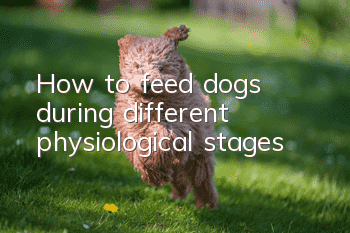How to feed dogs during different physiological stages?

Dogs go through four stages in their life: growth, early adulthood, late adulthood and old age. On the basis of this division, we call dogs in the growing stage puppies, dogs in the adult stage called adult dogs, and dogs in the elderly stage called senior dogs.
Now that you know how to distinguish the different physiological stages of dogs, you must want to know: Are the feeding requirements different at different stages?
Nutritional needs at different physiological stages
Puppy feeding
Lactation and weaning are two stages that puppies must go through. Puppies mainly eat breast milk within 30 days after birth, and they can be completely weaned about 50 days after birth.
Starting from the weaning period, owners can start to help their dogs make weaning dog food for transition. Owners can soak a small amount of puppy dog food in warm water, crush it, add dog milk powder, stir it into a paste, and feed it 3-4 times a day. Then gradually increase the proportion of dog food until it is completely replaced. At the same time, after 6 months after the dog is born, the daily feeding amount remains unchanged, but the frequency should be reduced to 2-3 times.
Growing puppies will usher in an important period of bone and muscle development, but this does not mean that you can let your furry children eat! Eat small and frequent meals is the correct operation, which can not only meet their nutritional needs, but also allow bone development It's normal, but it won't make them obese.
Adult dog feeding
The amount of food an adult dog should feed depends on multiple factors, including activity level, body size, whether it is pregnant and lactating, etc. Therefore, we can subdivide adult dogs into ordinary healthy adult dogs, pregnant adult dogs, and lactating adult dogs.
For ordinary healthy adult dogs, Kager believes that it is very important to help them develop good eating habits. In addition to regular, quantitative, and fixed-point feeding training, owners also need to frequently monitor their weight and adjust the feeding amount based on their weight changes.
Generally speaking, adult dogs should be fed once in the morning and once in the evening, or once every night. However, Kager recommends feeding twice a day, because this can shorten the dog’s fasting time and is very helpful in preventing obesity!
If your dog is pregnant or lactating, owners need to take into account the nutritional needs of the puppy. The gestation period for dogs is approximately 9 weeks. Typically, canine fetuses begin to grow rapidly around the fifth week of pregnancy, reaching a peak in the eighth week.
Therefore, starting from the fifth week, the owner can increase the feeding amount by 15% every week, and the food intake during delivery should be increased by 60% of that before pregnancy. In addition, Kager recommends that owners choose high-quality products for dogs at special stages.Complement their diet with pet food that is caloric, easily digestible, and rich in phosphorus and calcium.
Feeding for senior dogs
Just like humans entering their twilight years, aging dogs can also develop health problems such as digestive system degeneration, diabetes, obesity, and heart disease.
Therefore, when feeding elderly dogs, owners must reduce their dogs’ intake of salt and fat, and choose foods that are low in calories, high in protein, and easy to chew and digest. If the dog has difficulty chewing, owners can also soak the dog food in hot water for a few minutes before feeding.
After understanding the nutritional needs of dogs at each stage, the next step is to choose the appropriate product. As a New Zealand premium pet food brand, Kakato provides pets with dry food, wet food and healthy snacks in a variety of flavors. Kager's ingredients are all grown and raised from natural pollution-free sources. Owners can make different combinations based on the nutritional needs and feeding priorities of their furry children at each physiological stage with the advice of professional nutritionists. Kager also suggested: pairing wet food with dry food to provide a more balanced meal.
Dogs have three life stages: old, middle and young, and their growth rate is much faster than we think. Therefore, for owners, grasping the physiological stages of their dogs and adjusting their feeding focus in a timely manner can help their dogs grow healthily. One of the important methods! Have you learned it after reading this tweet?
*The above information is for reference only, please refer to the advice of professional pet doctors. Article source: Kakato Pet Food
- Diagnosis and treatment of canine esophagitis
- What are the symptoms of a cold in puppies?
- Why does a golden retriever drool so much?
- How much do you know about dog health? What are the common eye diseases in Chow Chows?
- Do mosquitoes bite dogs?
- Teddy vomiting
- Boxer dog daily care
- Can dogs eat fish food?
- How big and heavy can a golden retriever grow?
- Can a golden retriever be kept as a native dog?



